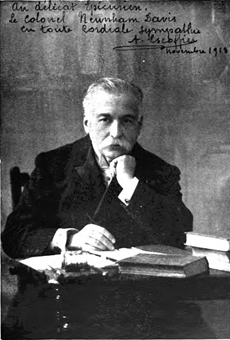BOOK REVIEW: The Cuisine Of Escoffier
|
When looking for a copy of August Escoffier’s Le Guide Culinaire on Amazon.com, we found an elucidating customer review by Charlene Vickers of Winnepeg, Canada. The great Escoffier (1846-1935) was a was a French chef, restaurateur and culinary writer who updated and codified traditional French cooking techniques. In 1903, he published what instantly became the culinary bible. One hundred and eight years later, it is still the classic reference source for professional chefs. An abridged English-language version, The Escoffier Cookbook and Guide to the Fine Art of Cookery: For Connoisseurs, Chefs, Epicures, Complete With 2973 Recipes, is half the cost of the original. Ms. Vickers responded to another customer’s complaints about this abridged edition with such depth, that we asked her permission to reprint her comments. We hope you enjoy this glimpse into culinary history. |
 August Escoffier. Photo from The Gourmet’s Guide to London (1914) by Nathaniel Newnham-Davis. Photo in the public domain. |
|
|
“The Escoffier Cookbook,” writes Ms. Vickers, “is a heavily abridged American version of Auguste Escoffier’s 1903 book, “Guide Culinaire.” It is a fascinating look at the art of professional European cookery at the beginning of the 20th century. “However, to appreciate this book fully, it’s important to understand exactly for whom it was written. Escoffier’s original guide was never for a second intended for the home cook. Escoffier was a pioneer with respect to the education of professional chefs, and originally wrote this book for the use of those working in grand houses, in hotels, on ocean liners, and in restaurants, who might not have had access to contemporary recipes. “Accordingly, the original book does not attempt to teach basic cooking or food preparation techniques. The American translation does include some details on cooking utensils and techniques unfamiliar to the average American chef (such as poeleing,* worth the cost of the book alone, and the old French form of braising), but even in the translation it is assumed that the reader is a trained, experienced chef. *Editor’s Note: Braising calls for liquids to be added to the meat. Poeleing uses just butter and the meat’s own juices, with no added liquids. “The recipes themselves are clear and simple to follow, but represent only a small subset of French cooking of the early 20th century. An earlier reviewer mentioned that there was no recipe for onion soup. This is true, but it should be understood that onion soup would never have been accepted by the class of restaurant patron for whom Escoffier cooked. “Much of what has arrived on this side of the Atlantic as ”French cooking”—dishes such as pot-au-feu, onion soup, and steak frites—is distinctly middle-class fare, and consequently would have been rejected by the clientele of quality restaurants of the time as being unspeakably boorish. Escoffier personally enjoyed bourgeois cooking, but as an astute, intelligent businessman, he provided the haute cuisine his clients demanded. “One interesting difference between modern cooking and the cooking featured in this book is that Escoffier uses few spices, and indeed declaims on the foolishness of using large amounts of spices in meat dishes. This appears bizarre from our vantage point, but Escoffier had sound economic reasons for his proscriptions. “Most diners of the time grew up in the days before refrigeration, when old, deteriorating meat was heavily spiced to make it palatable. Fresh, unspiced meat was a sign of the highest quality. The association between strong spices and poor quality was powerful enough to survive long into the 20th century, as any reader of a 1950s American cookbook can attest. “As for the recipes themselves, I doubt that many of them could be prepared by the North American home cook. Most of us cannot afford (if we can even find) foie gras, truffles, or capons, and few have espagnole sauce or fish fumet available at all times. However, many recipes can be adapted for the modern cook—using cepes or porcini mushrooms instead of truffles, for instance—and those that can be prepared really are delicious.” Thanks so much, Ms. Vickers. If we ever get to Winnepeg, we would love to take you to dinner—although it sounds as if we might enjoy even better fare in your kitchen.
|
||


